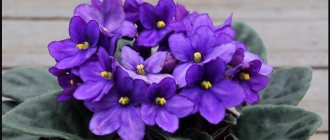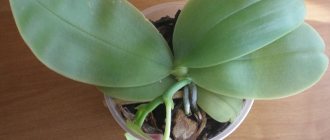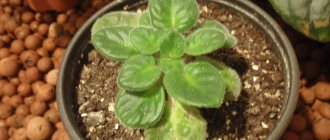Violet - description, photo
Uzambara violet is a common house flower. The small bush has a lush hat of different colors. The buds consist of five petals, collected in brushes. The colors are white, lilac, and red. Violets begin to bloom at one year of age, in the spring, when they begin to receive enough natural light.
indoor violet during flowering period
They bloom almost all year round, the frequency depends on the variety. The non-flowering period takes 2 months annually. When the Uzambara violet does not bloom for a long time, this indicates improper care. Violets are capricious indoor flowers, sensitive to external factors. Housewives love to grow them on windowsills; a bright, lush head of flowers fills the house with coziness.
Sometimes flowers, when healthy, do not bloom for a long time. The flower blooms rarely, until the flowering ability is completely canceled. Why could this be? It turns out that this depends on many factors. Only by analyzing the true reasons can you force the buds to bloom again.
Wick watering
The velvety leaves of violets are afraid of getting wet, so collectors came up with the idea of watering them using the wick method - water from a container located under the pot rises along the cord and is absorbed into the substrate. The cord should be synthetic, since natural ones rot quickly.
Related article:
Four best violet fertilizers for flowering with a cap
The wick is passed through the drainage hole. Usually buy plastic pots, they will still be placed in more decorative containers with water. The flowerpots are chosen to be small, since violets begin to bloom profusely only after their roots fill the entire earthen ball. The diameter of the planting pot should be three times smaller than the diameter of the rosette of leaves. A mixture of high-moor peat, coconut fiber and perlite is used as soil. The earthen mixture is not entirely suitable for violets, as it is somewhat heavy. Drainage is not needed with this method of watering.
The container with the planted violet is placed in a flowerpot with water. In this case, its bottom should rise at least half a centimeter above the water. That's all! It remains to ensure that the bottom pot does not become empty.
Wick watering of violets
Reasons why indoor violets do not bloom
Saintpaulias are heat-loving and require special care. For flowering, much attention should be paid to room lighting. With constantly poor daylight, the flowers begin to wither. Flowering becomes delayed, even completely absent. What other reasons are there why homemade Saintpaulias stop blooming?
Incorrect lighting
A common reason for violets to stop blooming. Lighting duration is required at least 12 hours. Natural or artificial lighting is suitable. Excessive light promotes healthy growth. Having good lighting is especially important from the very beginning of flowering. Lack of light is characterized by upward growth and stretching of stems. Normal condition - leaves lie around the pot. Excessive lighting contributes to fading and drying of leaves and buds.
the result of improper lighting of the violet
Lack of fertilizing
The plant needs to be fed regularly with the right preparations. It is recommended that flowers be provided with mandatory weekly feeding. Improper feeding is a common reason why Saintpaulias stop blooming. The main rule is not to overdo it with fertilizing nitrogen-containing preparations. Excessive feeding negatively affects lush flowering.
Incorrectly selected soil for planting in a pot
If you use ordinary soil from the garden for growing, problems with the health of violets will soon begin. The composition of the soil and the level of acidity greatly affect flowering. Watering washes away nutrients, turning them into clay. Hard, compacted soil makes it difficult for the root system to grow. The roots do not receive enough minerals - all parts of the plant suffer.
In addition to fertilizing the soil, they supply the soil with oxygen and make it loose. The soil must be breathable. You can purchase a special soil mixture and make it yourself. Wood ash, spruce sawdust, crushed moss, crushed bark, and peat are mixed with the soil.
Important! The amount of peat you need to take is less than the other ingredients. By promoting the growth of leaves, it will prevent the blossoming of buds.
Frequent temperature changes
A sharp change in temperature leads to the fall of the buds, stopping the flowering ability. It is recommended to keep the room temperature at medium temperature, neither low nor high. Recommended temperature is around 20 degrees. It is necessary to avoid sudden changes in heat and cold.
Under or over watering
The fading of a flowering species may be due to improper watering. The quality of irrigation water is important. Watering with hard, dirty, cold water is unacceptable. Tap water is left to settle overnight before watering. It is important not to overdo it with watering, otherwise the nutrients will quickly leave the soil with water. Due to lack of watering, the soil dries out, cracks, the leaves dry out locally, as if they were burnt by the sun.
violets only grow leaves
Diseases and pests
Saintpaulias are tender and sensitive to diseases and pests. If problems affect violets, the plant will have a hard time withstanding such trials. The main pests that harm Saintpaulias at home:
- nematodes - destroy the roots, the leaves become covered with white-green dots;
- aphids - eating the succulent part, kills the plant;
- mealyworms - suck out the juices, lay larvae on the back of the leaves;
- thrips - they eat leaves, which then darken and dry out completely, and can fly to other indoor plants in the room.
Diseases and pests can appear in winter and summer. You will have to completely change the soil to completely get rid of the problem. The reasons for the lack of flowers in violets are described in the video.
Genetic feature of the variety
Some varieties, due to their individual characteristics, have a small number of buds. Even ideal care, observing all the basic rules, deprives the plant of the opportunity to bloom. Depends on the characteristics of the variety, genetic predisposition. There are varieties that bloom once a year. Rarely bloom with a beautiful flowering lush cap. Healthy flowering does not affect frequent blooming, it depends on genetics, variety, species.
Important! You can get profusely blooming violets by understanding the varieties.
Thickened state in one pot
By planting several plants in one pot, rapid active growth will begin. The plants will quickly suck out the nutrients, and the condition will begin to deteriorate. To avoid an unfavorable situation, separating the stems and transplanting the sprout into a separate small pot will help.
lack of violet flowering - increased leaf density
Too big container for growing
After planting, Saintpaulias devote their remaining energy to the development of the root system. A larger pot requires more time for the roots to grow. A small container is needed to grow a flower.
Important! Pots with few holes interfere with healthy growth and flowering.
No transfers
If the violet has never been replanted into another soil, the poor condition of the violet is almost impossible to avoid. Any plant, even with regular feeding, must be replanted in a pot with new soil. It is recommended to carry out transplantation regularly after 7 months. Exceptional cases require immediate transplantation upon visual inspection. The flower became cramped in the pot.
Having reached the age of three, Saintpaulia stops blooming for natural reasons. They save the situation by cutting off the green parts of the plant. The process is called rejuvenation.
What should I do to have color?
Regular flowering of Saintpaulia depends on the variety. Some produce a few flower stalks, but try to bloom constantly. Others are distinguished by abundant and lush, but cyclical flowering.
In any case, it is better to give Saintpaulias a rest for one or two months, for example, in December-January or in the hottest months of summer. If plants attempt to produce flower stalks at this time, they should be carefully removed. These measures will help the violets recover and prolong their life.
Correct conditions and care
For regular and abundant flowering, the following is necessary:
- Choose the right soil .
The easiest way is to buy soil for violets in the store. It must be loose and light. The ratio “nitrogen (N) - phosphorus (P) - potassium (K)” in it should be approximately 1: 1: 2, for example, nitrogen - 5, phosphorus - 5, potassium - 9. That is, potassium should be approximately two times more than nitrogen or phosphorus. A third of the pot should be occupied by drainage, for example, expanded clay. Important! If the package with soil says in large letters that it is for Saintpaulia, you should not believe it right away. It is better to check the NPK information on the back of the package, written in small letters. - Select the desired pot . Now stores sell special numbered pots for violets, this is very convenient: for children - No. 5 or 6; for one-year-old plants - No. 7 or 8 and for adult plants - No. 9 or 10. If it is not possible to purchase such pots, you need to be guided by the upper diameter of the pot - starting from 5 cm (children) to 11 cm - adult plants.
- Water correctly . When watering, water should not fall on the leaves, growing point and stems of the plant. The soil should be slightly moist. If violets are left unattended for some time, you can use bottom watering through a tray or wick watering. Use only settled water at room temperature.
- Choose suitable lighting . The ideal place for violets is windows on the east side. Northern ones are not suitable due to lack of sunlight (except from May to July). But if other cardinal directions are used, then the plants need to be either shaded or placed not on the windowsill itself, but next to it. In autumn and winter, when daylight is short, violets need additional lighting.
- Feed well and on time . During flowering, violets need to be fed every two weeks. The fertilizer, like the soil, should contain more potassium. “Agricola for flowering plants” is well suited. “Agricola” fertilizer is convenient for use in sticks, which are placed in the soil and release nutrients gradually until they are completely dissolved.
- Create suitable temperature conditions . The optimal temperature for Saintpaulias is from +18 to +24 °C.
- Provide the required humidity . The air around Saintpaulias should be regularly moistened, for example, from a spray bottle. And in winter, place bowls of water near the pots.
- Protect from drafts . Pots with flowers should be placed in a quiet place - away from cold air currents, be it open vents and windows or air conditioning.
- Cherish . It is necessary to ensure that the leaves are not damaged, for example, by sharp edges of the pot, animals, children, when rearranging or watering.
- Seating . There is a basic rule: one pot - one plant. If children appear, wait until they have two or three pairs of leaves and plant them. If propagation of one variety is not required, simply remove it without waiting for it to grow.
- Remove stepsons . Stepchildren must be ruthlessly removed, there is no benefit from them, and it is also useless to root them.
Stimulating Saintpaulia
You can stimulate the flowering of Saintpaulias first of all with proper care. In addition, additional activities help:
- Removing old leaves . They need to be carefully broken out - take the petiole at the base with two fingers and move it to the side. You can cut it with a sharp knife, but there is a risk of cutting the stem. After removing the leaf, there should be no stump left.
- Transplant .
If your violets stop blooming but look healthy, it's probably time to replant them. It is recommended to do this once a year. An alternative is to partially replace the soil that is washed away during irrigation. Saintpaulias need to be replanted in the intervals between flowering, but closer to spring. - Rejuvenation . Old violets can be rejuvenated. The easiest way is to sprinkle the bare stem with new soil up to the rosette.
- The second is to use a sharp knife to cut off the rosette from the stem, stepping back from the lower tier of leaves by one and a half to two centimeters. After this, the rosette is either rooted in a glass of water and then planted in a pot, or immediately placed in a pot. But in the second case, the soil must be very loose, and in no case should it be compacted near the stem. Water in a thin stream along the edge of the pot, and it is better to use bottom watering.
If Uzambara violets do not bloom, do not rush to get rid of them. We must determine the reasons for their behavior and try to correct them. There is one more piece of advice: you need to talk to violets, praise them, sometimes scold them or even scare them, but only show that you are interested in them. Plants are very responsive to people’s moods and try to reciprocate.
What to do if violets do not bloom after transplanting
Caring for Saintpaulias at home is required based on the identified main reasons for the lack of flowering. Care rules must be followed after transplanting indoor Saintpaulias. It is easier to preserve young ones than to force older ones to bloom.
Pay attention and monitor the frequency of watering
The condition of the soil changes with excessive watering. It becomes dense, similar in consistency to clay. As they dry out, cracks appear on top and the leaves begin to darken. With a lack of watering, the soil dries out in clumps, the buds fall off, and the edges of the leaves dry out. The initial stage begins with the removal of diseased leaves. The soil is always left slightly moist, but soft. Water from below, directly into the soil at the base of the stems. Use water at room temperature, soft.
violet does not bloom at home
It is necessary to create additional air humidity near the plant
In winter, air humidity in a heated room is about 20-30%, violets require 50%. You need to hang wet towels over the radiators and place a couple of shallow plates with water nearby.
Attention! If parasites have managed to damage one of the pots with homemade violets, it is recommended to throw out the plant immediately.
The right place and minimal care
Claiming to be the favorite indoor plant, the baby Saintpaulia is suitable even for novice gardeners. There is nothing difficult about growing it. In the case of Saintpaulias, problems are very rare. But if they arise, they are invariably associated with flowering. Saintpaulia's ability to bloom tirelessly, for a long time and without special stimuli is unique. Therefore, flowering disturbances are noticeable much more clearly than in plants that require a long preparation and pause.
As with almost any issue related to development and flowering problems, prevention is the most effective method of control. And in indoor violets, preventing problems that would cause a lack of flowering is indeed much easier than making serious mistakes.
If it grows upward and does not bloom
The blooming species depends on many factors, including the variety. A plant that does not bloom for more than six months is in most cases due to improper care. Why doesn't indoor violet bloom? It is necessary to take action in time, otherwise it will be too late to save.
In addition to the lack of buds blooming, if timely measures are not taken, the color of the Saintpaulia leaves will change. They begin to turn brown, turn yellow and then dry out. The following steps will help you get rid of the factors that interfere with the flowering of Saintpaulia:
- For pests, stores sell special preparations for spraying and pollinating the soil. A weak solution of manganese when sprayed gets rid of gray rot. If aphids, mites and mealyworms harm the flowers, first wash the top part with soapy water. In case of advanced situations, spray with phytoverm.
- If flowering has stopped in cold weather, the senoplia most likely needs to be insulated. Place the pot on top of an object with poor cold conductivity. The most easily accessible option is polystyrene foam. Be sure to avoid drafts and sudden temperature changes. Important! At night, Saintpaulias need coolness, during the day - moderate light, warmth - 20 degrees.
- If violets grow upward and do not bloom for a long time, the required lighting is not available. The daily requirement of light for Saintpaulias is 12 hours. On cloudy days, with the onset of autumn, sunny days decrease. During this period, artificial lighting lamps are used.
- The next stage of pulling the leaves up is to curl them. In an advanced situation, it is difficult to save old foliage. Don't worry if it starts to fall off. Subsequent proper care will contribute to the appearance of new young leaves that will grow properly.
the leaves of the homemade violet are curling
Pests
When pests appear, the immunity of violets is greatly deteriorated, so they simply do not have the strength to bloom. The plant can be attacked by aphids, mealybugs, thrips, whiteflies, mites and other parasites. However, you can prevent the appearance of pests by observing all the conditions for keeping violets.
But even if you carefully monitor the condition of the flower, do not forget to carry out regular inspection (once every 1-2 weeks).
Check leaves and stems for strange spots, plaque, or sores.
If you find signs of pests, find out what you are faced with and start treating the flower as quickly as possible.
There are many leaves, but the violet does not bloom
There are times when the plant looks visually healthy. The foliage is lush and bright green, but the violet bush does not bloom. What is recommended to do to make the buds bloom?
Reasons: 1. Large amounts of nitrogen can accumulate in the soil. It is necessary to reduce the frequency of nitrogen fertilizing. 2. The bush in one pot has thickened. A transplant with division of the uterine bush is necessary. Each stem is transplanted into a separate pot.
Solution to the problem: 1. Transplant into new soil. 2. To prevent further loss of buds, it is necessary to fertilize the soil with a special preparation with a high phosphorus content. The soil should be loose; for this it is recommended to mix it with spruce sawdust, peat and crushed moss. 3. It is recommended to choose small pots, otherwise all the energy will be spent on growing the root system.
Important! It should be replanted in the spring, during the natural beginning of flowering season.
Big pot
If you plant a flower in a large pot, it will fill the container, putting all its energy into developing the root system.
In addition, in a deep container, the violet will actively grow green mass, so you may not wait for a long time to start flowering.
You should also not choose a miniature pot, because the flower will develop slowly and feel uncomfortable in it. The small volume of the container is also harmful because the soil in it is quickly depleted.
How to make it bloom at home
With proper care you can achieve flowering of Saintpaulia. The measures taken are followed, the plant looks healthy, but the formation of buds stops. It is advised to give a small shock shake in order to start the blossoming process. Gardeners sometimes resort to unconventional ways to save the situation:
- Cut off all the leaves, leaving 5-6 pieces. To dry the sections, leave them in a sunny place, then put them away in a dark place for a month. During this period, water the flower once. After the required period has passed, the pot is returned to its original place. In a month, the renewed Saintpaulia will begin to bloom.
- Using brewed black tea instead of fertilizing. This method keeps the soil loose for a long time. Advice! Black tea attracts midges, you should change the feeding more often.
- Citrus infusion for root feeding. Fresh or dried citrus zest is poured with hot water and left for two days. Fertilize once a month. Fill the tray with infusion and place the pot on top. Leave for half an hour, remove the pot on top of the expanded clay to remove unnecessary moisture.
- Outside root feeding from pharmaceutical glucose. One tablet is dissolved in a liter of water kept to room temperature. Spray the above-ground part with the solution once every two weeks.
- A tablespoon of sugar sprinkled on top of the soil before watering will cause the violet to open its buds after several treatments.
- Fertilizing with yeast is an effective means of promoting the blossoming of Saintpaulia. Its nutritional capacity can be compared with mineral fertilizers. A pinch of yeast and sugar is dissolved in a liter of warm water. Water the plant with the solution.
- It is recommended to carry out foliar feeding on cloudy days so that the plant avoids burns and rotting. In winter, when the violet is resting, fertilizing is reduced. Carry out only when necessary.
Common mistakes in care
- incorrect location of the violet and lack of lighting;
- insufficient humidity;
- temperature violations in any direction and drafts;
- large flowerpot and incorrect soil;
- errors in the watering mode - drying out or excess moisture;
- excess nitrogen and lack of phosphorus and potassium during feeding.
All these violations can ultimately disrupt or completely stop the process of bud formation, so you should carefully follow the regimes for keeping Saintpaulia in indoor culture.
Signs - why the violet does not bloom
Indoor Saintpaulias fill the atmosphere of the home with comfort. It is believed that violets in the apartment have magical powers and can change fate. There are popular beliefs about the influence on the lifestyle of household members. Most often, the nature of the energy influence on fate depends on the color of the bud. However, there are several bad omens associated with violets. Most signs about unblown Saintpaulias are negative. If violet:
- was bought from an unknown woman, does not bloom, it promises a dark streak in life;
- does not bloom on an unmarried woman - she will remain unmarried;
- with red buds that have stopped blooming - someone in the house will die;
- They do not bloom for a long time, at night they suck energy from their owners, like vampires.
- does not bloom with white buds, then there will be discord in the family, bad thoughts will consume the mind;
- does not bloom with purple buds - it will bring stress and nervous conditions to the owners;
- placed with a pot near the child’s bed and does not bloom, it will lower the immune system and make him more susceptible to disease.
Whether to believe in omens is up to everyone. However, the negative “vampire” influences of violets have been proven by scientists. The violet releases oxygen only during the day and releases carbon dioxide at night. This causes morning headaches, dizziness, weakness, and general poor condition of the body. It is better to listen to scientists and avoid placing a potty in the bedroom.











